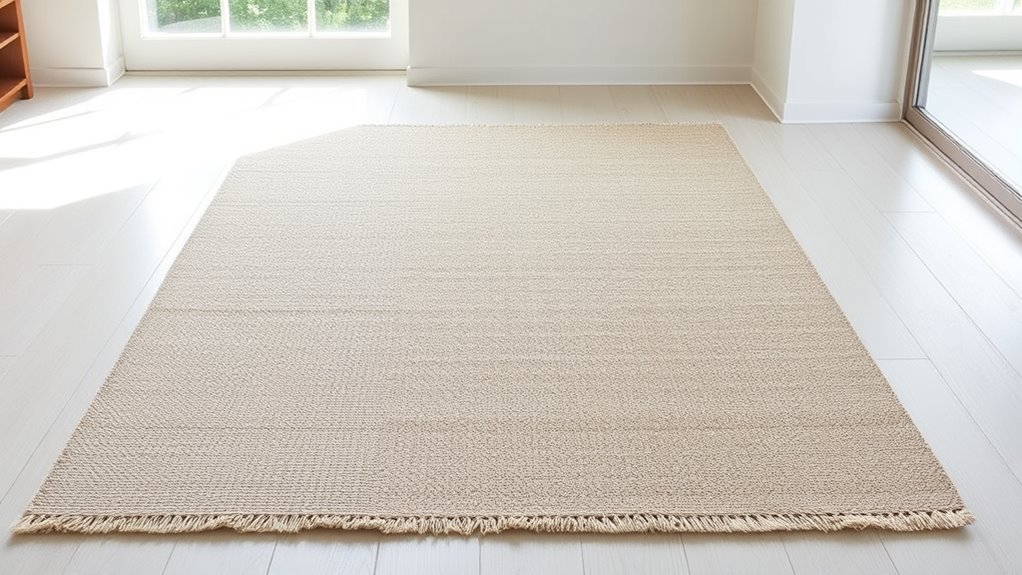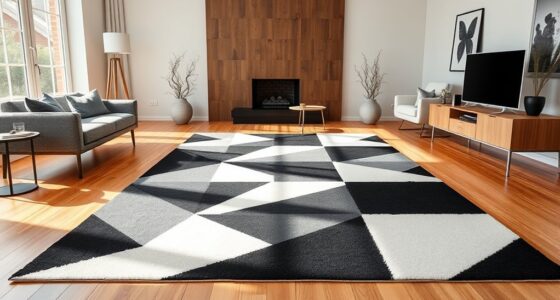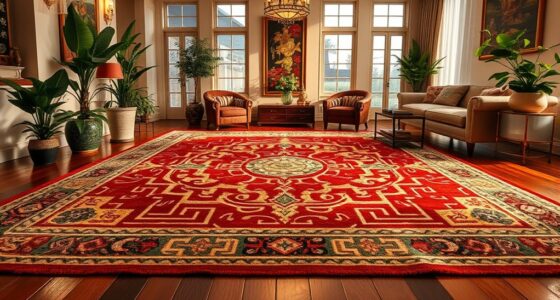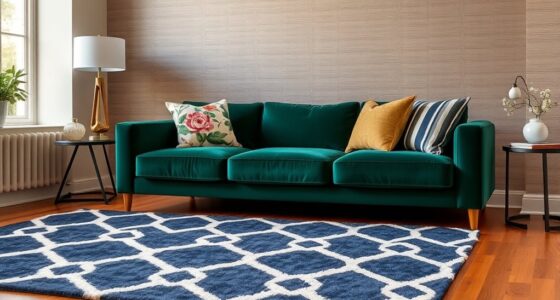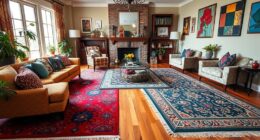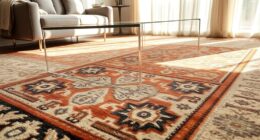When building a minimalist rug palette with neutral tones, focus on selecting calm, versatile shades like beige, gray, or taupe that complement your space and lighting. Mix warm and cool neutrals to add depth, and incorporate textures or subtle patterns to create visual interest without clutter. Using layered tones and textures helps maintain a serene environment that’s adaptable and timeless. Keep exploring to discover how textures and patterns can enhance your neutral rug choices even further.
Key Takeaways
- Select base shades like beige, gray, or taupe that complement natural light and existing furniture.
- Pair warm and cool neutrals to create contrast and visual interest within the palette.
- Incorporate varied textures and subtle patterns to add depth without cluttering minimal spaces.
- Test shades in different lighting conditions to ensure consistent feel throughout the day.
- Use layered neutrals with harmonious undertones for versatile, timeless rug choices.
Understanding the Power of Neutral Colors in Minimalist Design
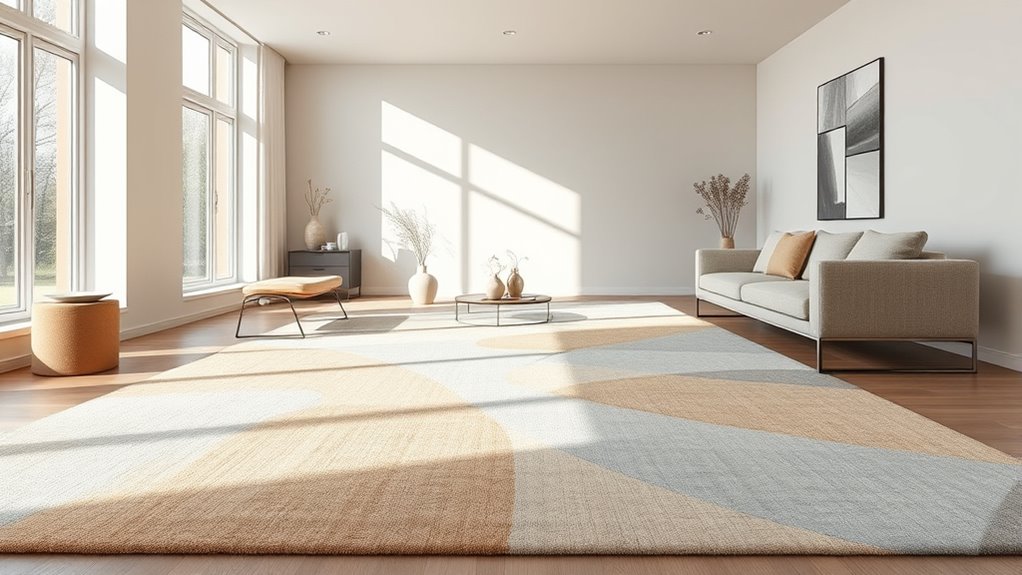
Neutral colors play a crucial role in minimalist design because they create a calm, balanced environment that highlights simplicity. These tones, such as beige, gray, and soft whites, serve as a subtle backdrop that doesn’t overpower the space. They help you achieve a sense of harmony and serenity, making rooms feel more open and inviting. Neutral colors also offer versatility, allowing you to easily mix and match different textures and materials without clashing. By choosing these shades, you emphasize clean lines and uncluttered spaces, fostering a peaceful atmosphere. Their understated elegance ensures your design remains timeless, preventing trends from quickly fading. Ultimately, neutral tones enable you to focus on the beauty of the space itself rather than being distracted by bold colors. Additionally, incorporating AI tools can assist in selecting the perfect shades and textures to enhance your minimalist aesthetic.
Selecting the Perfect Base Shades for Your Rug Palette
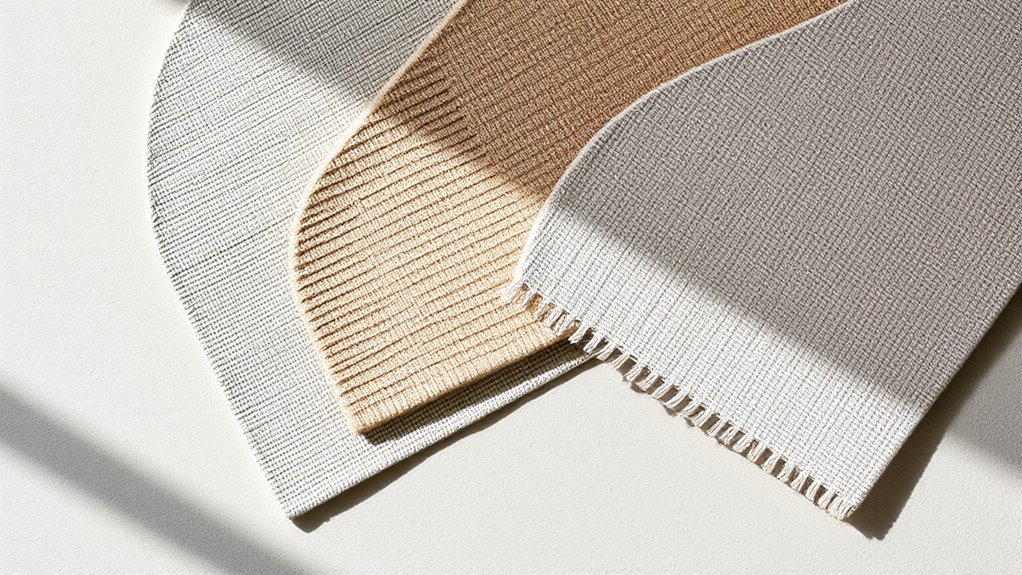
Choosing the right base shades for your rug palette sets the foundation for a cohesive and harmonious space. Start by identifying your room’s primary light sources and existing furniture tones. Opt for neutral shades like soft beiges, warm grays, or subtle taupes that complement these elements without overpowering them. Consider the mood you want to create—calm and serene or warm and inviting—and choose shades accordingly. Keep in mind that lighter bases can make a room feel more spacious, while darker neutrals add depth. Test your chosen shades in different lighting conditions to see how they shift throughout the day. Remember, your base shades should serve as a versatile backdrop, allowing you to layer textures and accents effortlessly.
Combining Neutrals for Depth and Visual Interest
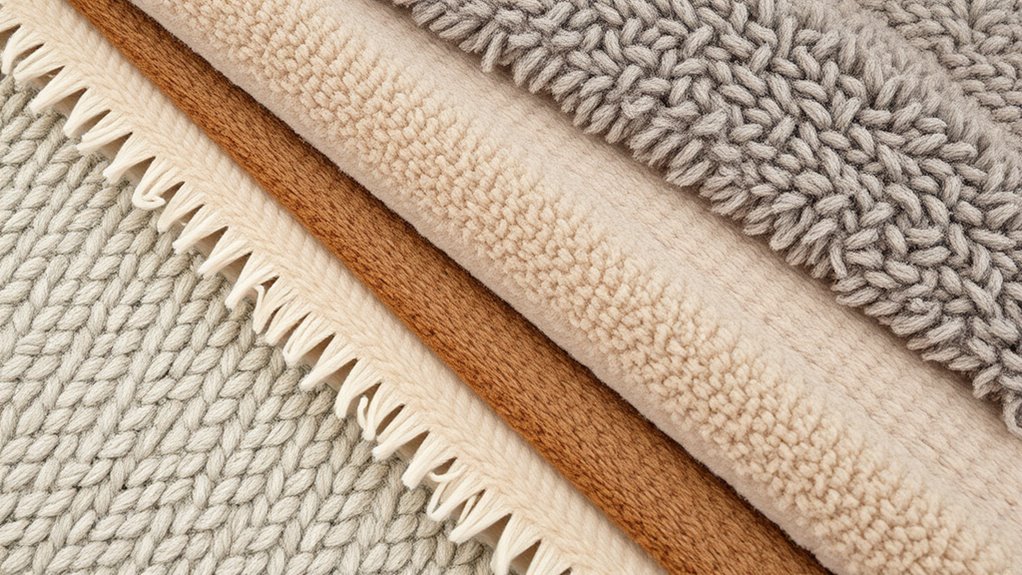
To create a dynamic and inviting rug display, you can combine different neutrals to add depth and visual interest. Pairing warm beiges with cool greys, for example, creates contrast that keeps the space lively. Mixing textures like plush and woven neutrals enhances the tactile appeal. Using varying shades within the same neutral family prevents the palette from feeling flat. Incorporate subtle differences, such as an ivory base with taupe accents, to add dimension. Layering light and dark neutrals guides the eye across the rug, making it more engaging. Here are some ways to achieve this:
Create depth by combining warm and cool neutrals with varied textures and shades for an engaging rug display.
- Combine warm and cool tones for contrast
- Mix matte and textured finishes
- Use varying shades within the same hue
- Pair light neutrals with darker accents
- Incorporate subtle pattern variations
Tips for Maintaining Versatility With Neutral Tones
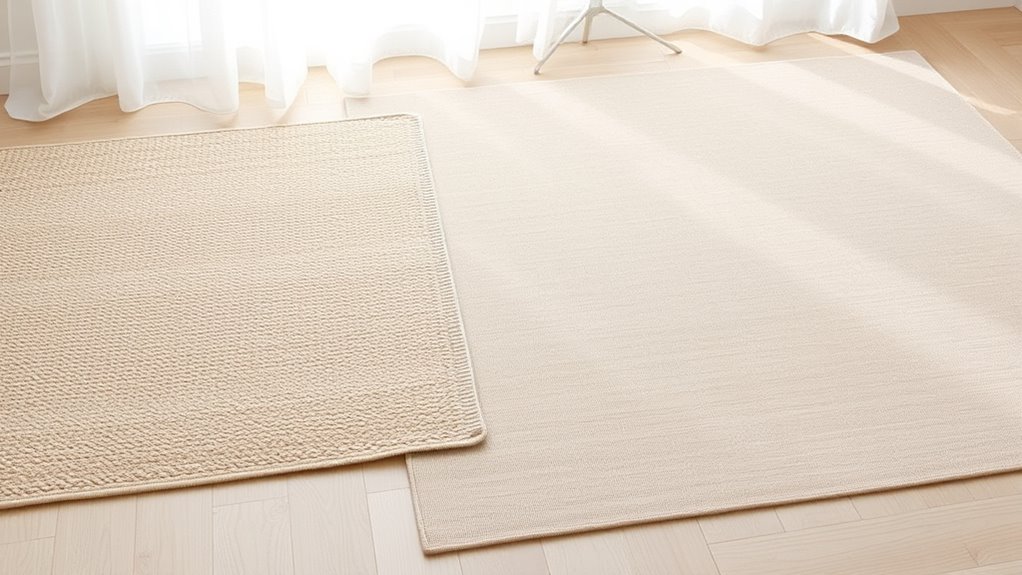
Since neutral tones are inherently adaptable, maintaining their versatility involves strategic choices that guarantee they complement a variety of styles and color schemes. Focus on selecting shades that lean toward warm or cool undertones, ensuring flexibility in different environments. Pair your neutral rug with diverse accent colors for easy updates and seasonal changes. Incorporating layered textures can further enhance visual interest while preserving the minimalist aesthetic.
Incorporating Textures and Patterns to Enhance Neutral Rugs
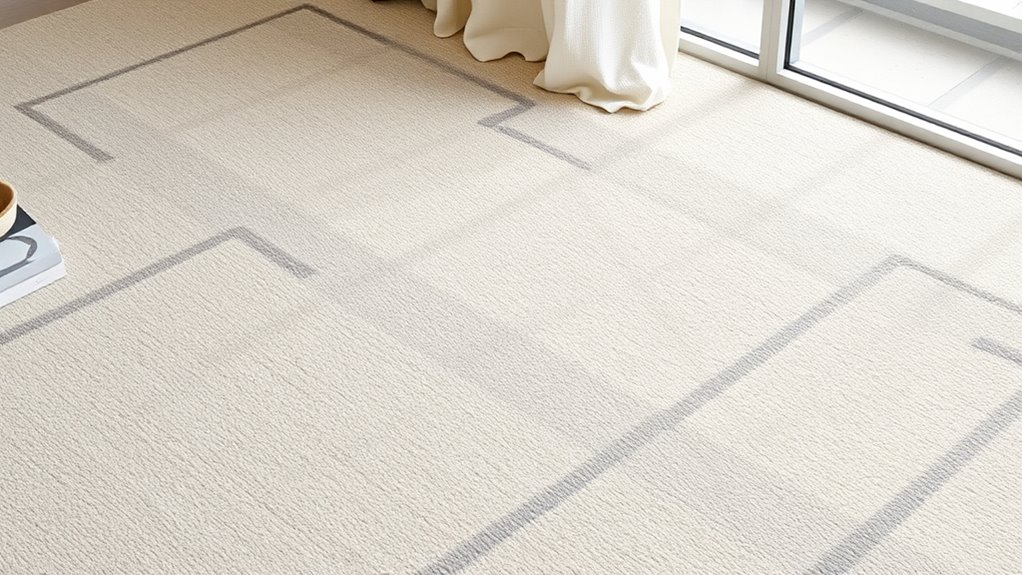
Have you ever noticed how adding textures and patterns can transform a neutral rug from bland to mesmerizing? By incorporating varied textures like shag, boucle, or woven elements, you add depth and tactile interest to your space. Patterns such as geometric shapes, subtle stripes, or organic motifs can break up monotony while maintaining a minimalist aesthetic. Mixing different textures creates visual intrigue without overwhelming the room. Similarly, layering patterned rugs can define zones or add personality. Be mindful of scale and contrast to keep the look cohesive. Remember, the goal is to enhance, not clutter. Thoughtfully selected textures and patterns can elevate your neutral rug, making your space feel more dynamic and inviting. Exploring design principles can help you balance these elements effectively.
Frequently Asked Questions
How Do Neutral Tones Influence the Overall Mood of a Space?
Neutral tones create a calm, balanced atmosphere in your space. They help you feel relaxed and focused by reducing visual clutter. When you incorporate neutral colors, you make your environment feel more spacious and inviting. These tones also serve as versatile backgrounds, allowing you to add pops of color or textures without overwhelming the room. Overall, neutral shades promote serenity and simplicity, making your space feel harmonious and timeless.
What Are Common Mistakes to Avoid When Choosing Neutral Rugs?
When choosing neutral rugs, you wanna avoid common mistakes like selecting colors that clash with your existing decor or choosing rugs that are too busy in pattern, which can disrupt the minimalist vibe. Don’t overlook the rug’s texture—opting for overly shiny or rough surfaces can throw off the balance. Also, forget to contemplate the size; a rug that’s too small or large can make the space feel awkward.
Can Neutral Palettes Work in Small or Dark Rooms Effectively?
You might wonder if neutral palettes work in small or dark rooms. The answer is yes, they can be very effective. Light neutral rugs reflect natural light, making the space feel bigger and brighter. In dark rooms, neutral tones add warmth without overwhelming the space. Pairing them with good lighting and minimal decor enhances the room’s openness and coziness, creating a balanced, inviting atmosphere.
How Do I Layer Multiple Neutral Rugs Without Creating Clutter?
Imagine stacking pillows on a bed—too many can feel overwhelming. When layering neutral rugs, choose different textures and subtle shades to create depth without clutter. Keep the sizes varied but balanced, with one anchor rug and smaller accents. You’ll add visual interest while maintaining a clean, minimalist vibe. Remember, less is more; carefully curated layers enhance your space without making it feel chaotic or crowded.
Which Materials Are Best for Maintaining Neutral Rugs’ Appearance Over Time?
When choosing materials for maintaining your neutral rugs’ appearance over time, opt for durable, stain-resistant fibers like wool, nylon, or polypropylene. These materials resist wear, fading, and dirt buildup, helping your rugs look fresh longer. Regular cleaning and prompt stain removal also preserve their look. By selecting high-quality, resilient fabrics, you guarantee your minimalist rug palette stays clean and elegant, enhancing your space’s serene vibe over the years.
Conclusion
By mastering the art of neutral tones, you’re on the brink of transforming your space into a serene sanctuary. But the real magic happens when you start blending textures and patterns—are you ready to uncover the secrets that will elevate your minimalist rug palette to stunning new heights? Keep exploring, experiment boldly, and soon, you’ll discover how these subtle shades can open a world of endless design possibilities. The next step is yours—are you prepared to take it?
